
Pan Liners Buying Guide
Baking pan liners are a crucial tool for commercial bakers looking to achieve perfect results with their baked goods. These liners are designed to fit inside many different types of baking pans, providing a non-stick surface that helps prevent food from sticking to the pan. Because baking pan liners are available in a range of materials, it can be tricky to choose the right liner for your needs. We'll go over the types of liners and their best applications to help simplify your shopping experience.
Shop All Pan Liners
Types of Disposable Pan Liners
Disposable pan liners are coated with different materials that provide a non-stick quality for quick release. Each type of disposable pan liner offers unique benefits that cater to specific baking needs. Here are the common types of disposable pan liners to consider:
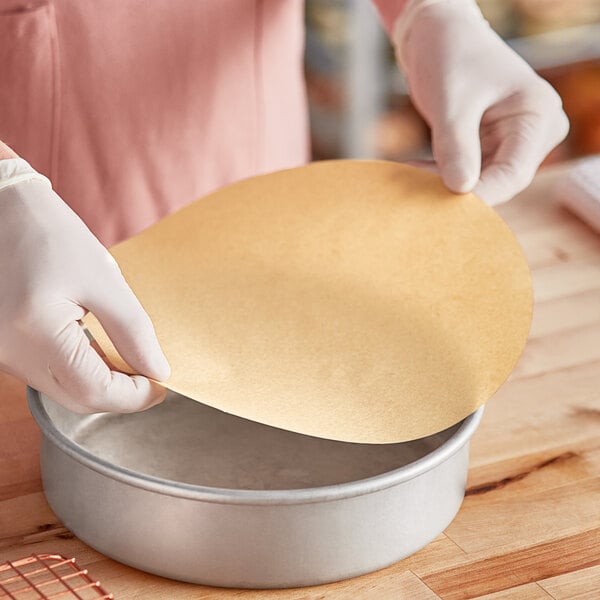
Quilon® Coated Liners
Quilon® coated pan liners are a popular choice among bakers for their non-stick properties and ease of use. These liners are coated with Quilon®, a chemical compound that provides a smooth surface for easy release of baked goods. Quilon® coated pan liners are ideal for baking tasks that require minimal sticking and effortless removal of food items.
- Temperature: Excellent for temperatures up to 400 degrees Fahrenheit
- Coating: Treated with a Quilon® non-stick coating that resists grease
- Best Uses: Great for multi-purpose, single-use baking
- Sizes: Offered in full sheets, half sheets, and quarter sheets
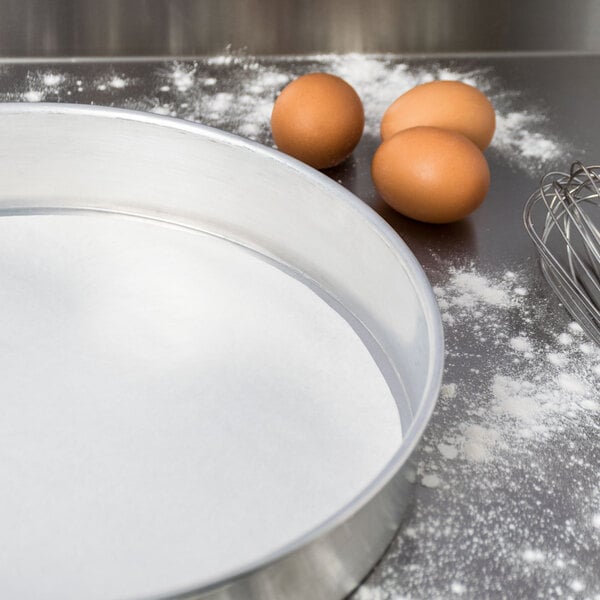
Dry Wax Paper Liners
Dry wax pan liners are designed to provide a grease-resistant barrier between the baking pan and the food. These liners are coated with a dry wax material that prevents oils and liquids from seeping through, keeping your baked goods fresh and free from excess grease. Dry wax pan liners are ideal for baking tasks that involve moist or oily ingredients. Unlike regular wax paper, dry wax paper is oven-safe and won't leave a waxy residue behind.
- Temperature: Oven-safe up to 400 degrees Fahrenheit, only if the liner is completely covered by a batter or dough (do not expose directly to an oven's heat)
- Coating: Embedded dry wax
- Best Uses: Batter and dough with high moisture content
- Sizes: Round sizes ranging from 6" to 12"
Please Note: When using dry wax paper, it must be completely covered by dough or batter. Dry wax should never be exposed directly to an oven's heat or it could catch fire.
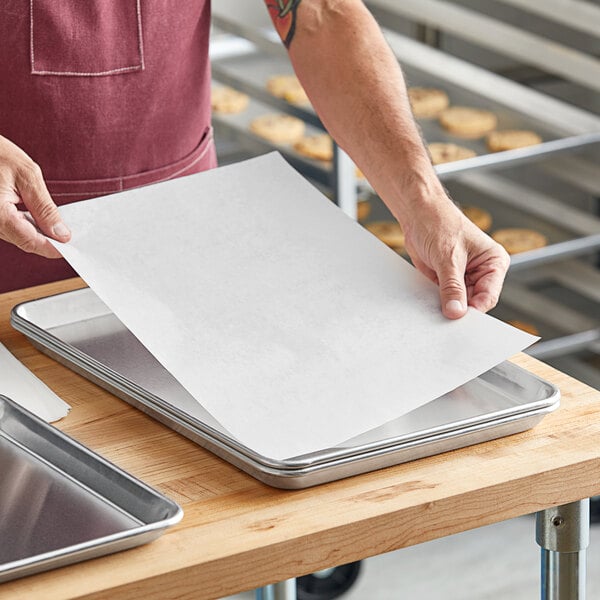
Silicone-Coated Pan Liners
Silicone-coated pan liners are known for their high heat resistance and durability. These liners are coated with silicone, a flexible material that can withstand extreme temperatures without melting or degrading. Silicone coated pan liners are suitable for baking applications that involve high heat levels and prolonged baking times.
- Temperature: Excellent for temperatures up to 440 degrees Fahrenheit
- Coating: Treated with a silicone non-stick coating that resists grease
- Best Uses: Great for low-fat and high-sugar baking and doughy foods (donuts and cinnamon rolls)
- Sizes: Offered in full sheets and half sheets
Types of Reusable Pan Liners
If you're looking for a more eco-friendly alternative to disposable pan liners, a reusable liner might suit your needs. Reusable pan liners are made from durable materials such as silicone or fiberglass. The pan liners are designed to withstand high temperatures and repeated use, making them a cost-effective choice for commercial bakeries.

Fiberglass Silicone Baking Liners
Fiberglass silicone baking liners are typically constructed with a fine-weave fiberglass mesh that is coated with food-grade silicone. The fiberglass provides stability and heat resistance, while the silicone coating ensures that baked goods release easily without the need for additional greasing or flouring. One key difference between fiberglass silicone baking liners and pure silicone liners is the added strength and durability that the fiberglass component provides. While pure silicone liners are flexible and non-stick, they may not offer the same level of support for heavier baked goods.
- Temperature: Withstands temperatures ranging from -40 degrees Fahrenheit to 480 degrees Fahrenheit
- Number of Uses: Typically lasts 3000-5000 bakes
- Coating: Fiberglass weave coated in premium food grade silicone
- Best Uses: Ideal for heavy baked goods, sticky foods like toffee, and delicate cookies like macarons
- Sizes: Available in quarter, half, full, and extra large sizes

Perforated Fiberglass Silicone Baking Liners
Similar to traditional fiberglass silicone baking mats, these perforated mats feature small holes in the liner that allow for better air circulation around the food. Compared to non-perforated baking liners, perforated fiberglass silicone liners offer improved airflow, which is beneficial for items that require a crispy texture, such as bread, pastries, and pizzas. The perforations also help to drain excess moisture from the food, promoting a more uniform bake and preventing sogginess.
- Temperature: Withstands temperatures ranging from -40 degrees to 500 degrees Fahrenheit
- Number of Uses: Typically lasts 3000-5000 bakes
- Coating: Fiberglass weave coated in premium food-grade silicone with micro-perforations
- Best Uses: Provides optimal browning for breads, eclairs, cream puffs, and croissants
- Sizes: Available in half, full, extra large, and round sizes
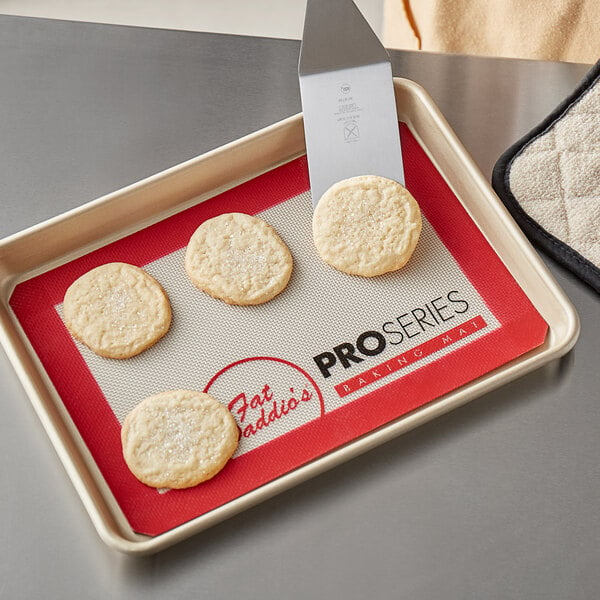
Pure Silicone Baking Mats
Pure silicone baking mats are made of high-quality silicone material that is food-grade and safe for use in baking. They're extremely flexible and provide a quick release, especially for sticky foods. Silicone mats are best used for a variety of baking tasks, including baking cookies, pastries, bread, and other confections. These mats provide a non-stick surface that allows for easy removal of baked goods without the need for additional greasing or oiling. They also promote even heat distribution, resulting in consistently baked products with a golden brown finish.
- Temperature: Withstands temperatures ranging from -40 degrees to 500 degrees Fahrenheit (some brands have a lower range)
- Number of Uses: Typically lasts 2,000 to 3,000 bakes
- Coating: 100% silicone
- Best Uses: Rolling fondant or dough, baking cookies and pastries
- Sizes: Available in quarter, half, full, and extra large sizes
Benefits of Using Pan Liners
Baking pan liners are a valuable investment for commercial bakers looking to streamline their baking process, improve the quality of their baked goods, and maintain the longevity of their baking equipment. Check out these benefits:
- Save on Food Cost: One of the key benefits of using baking pan liners is that they eliminate the need for greasing pans with oil or butter, saving time and ensuring consistent results. By using liners, bakers can easily remove their baked goods from the pan without any sticking or tearing, resulting in beautifully presented products every time.
- Protect Your Pans: In addition to preventing sticking, baking pan liners also help to protect the surface of baking pans, extending their lifespan and reducing the need for frequent cleaning. This is especially important in a commercial kitchen where efficiency and cleanliness are top priorities.
- Available in a Range of Sizes and Materials: Moreover, baking pan liners come in various materials such as parchment paper, silicone, and reusable non-stick liners, allowing bakers to choose the best option based on their specific needs and preferences. These liners are also available in different sizes to fit a wide range of baking pans, making them versatile and convenient for various baking applications.
Overall, By incorporating these liners into their workflow, bakers can achieve consistent and professional results with every batch of baked goods.
Related Resources

September 2024 WebstaurantStore Coupon Code
Fall is almost here, and to celebrate Webstaurantstore is offering a selection of amazing deals! In September, you'll discover incredible prices on classic fall flavors, glassware, cold cups, and much more! Take a look at our selection of sale items below and don't forget to enter the code COZY24 at checkout to enjoy savings of up to 25%! We're also excited to introduce the new Webstaurant Rewards® Visa Business Card ! Sign up for a new card today and start earning rewards on every WebstaurantStore purchase. Discover the latest discounts on consumable food and beverage items with September's monthly coupon code. From ready-to-bake pastries to classic fall flavoring mixes, you can find great deals on essential consumables for your commercial
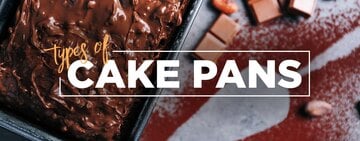
Types of Cake Pans
From birthdays to weddings and holidays, we celebrate life's milestones over a slice of cake. Selecting the proper cake pan is as essential as using the appropriate type of flour for achieving ideal baked good consistency, flavor, and appearance. The wide variety of available cake pan shapes and styles make it difficult to know which is the best type of baking pan for your task. To help you make your selection, below is information on the most common types of cake pans and their uses. These are the top 10 types of cake pans. Click on any of the cake pan types to learn more. Traditional Cake Pans Springform Pans Silicone Cake Molds Bundt Cake Pans Cupcake Pans or Mini Cake Pans Cake Rings Angel Food Cake Pans or Tube Pans Sheet Cake Pans Nov
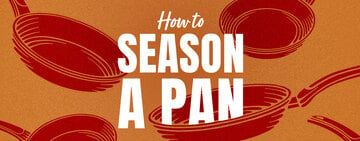
How to Season a Pan
Seasoning a pan is a crucial step in maintaining its non-stick properties and preventing rust. Whether you're using cast iron, carbon steel, or stainless steel pans, proper seasoning is key to achieving professional results in your commercial kitchen. We created a resource to help you learn how to season different types of pans effectively and take your cooking to the next level. Shop All Frying Pans Use the following links to learn about seasoning the different types of pans in your kitchen: What Does It Mean to Season a Pan? Pans Seasoning Video How to Season a Pan for the First Time How to Season a Pan in the Oven How to Season Cast Iron Pans How to Season Hard-Coat Aluminum Pans How to Season Tin Plate Pans How to Season a Pan on the St
- Topics 1404
- Industrial 55
- Troubleshooting Guides 23
- Restaurant Management 130
- Bar Management 59
- Catering Tips 38
- Bakery Management 43
- Food Trucks & Concessions 50
- Advertising & Marketing 37
- Eco-Friendly Tips 11
- Facility Layout & Design 44
- Coffee Shop Tips 30
- Installation & Maintenance 55
- Janitorial & Pest Control 30
- Safety & Sanitation 95
- Startup Tips 104
- Menu Design 10
- Kitchen & Cooking Tips 85
- Hospitality Management 24
- Pizza & Sandwich Shop Tips 37
- Smallwares 37
- Food Prep 97
- Tabletop Items 18
- Disposables 23
- Calculators & Tools 6
- Consumables 53
- Warewashing & Laundry 18
- Cooking Equipment 96
- Food Storage & Refrigeration 52
- Beverage Equipment 38
- Office Supplies 6


